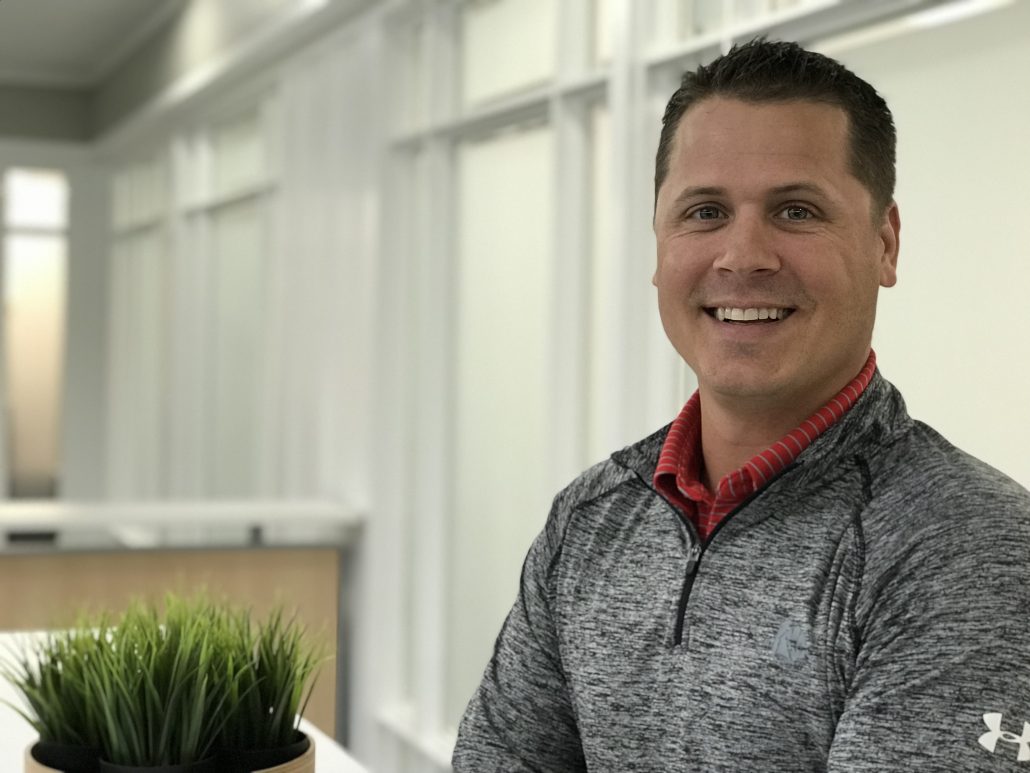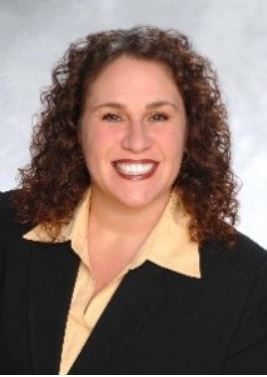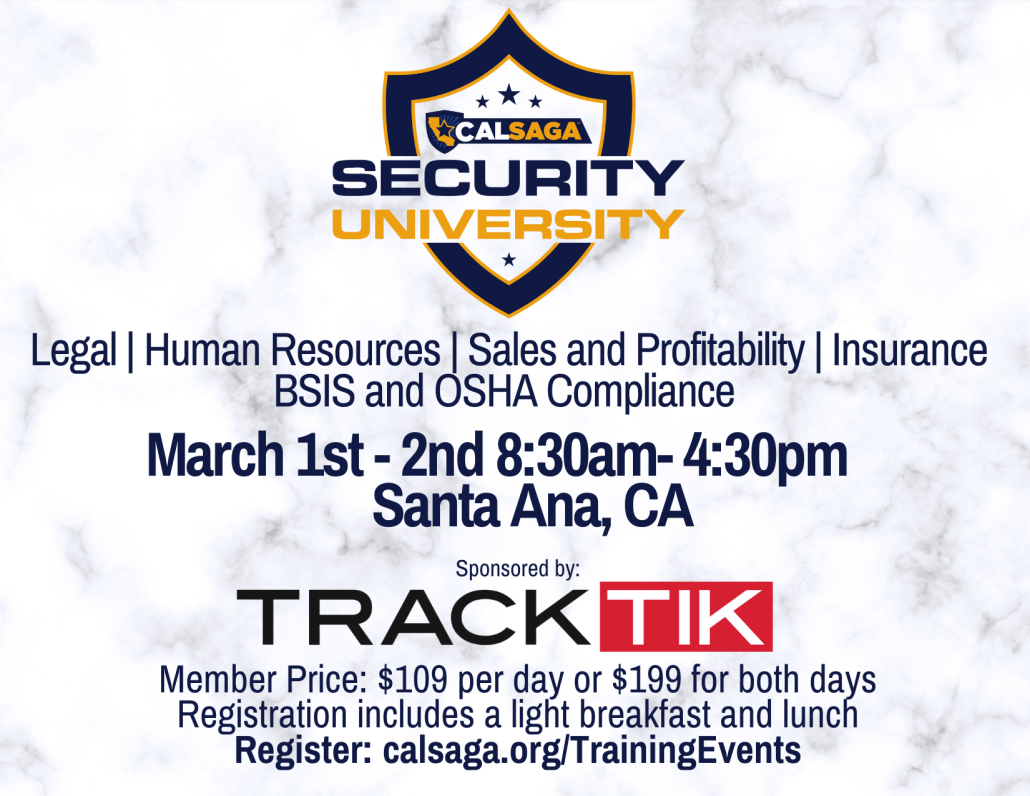Make plans to attend these upcoming events!
This two day management training program is appropriate for both industry veterans and those new to the industry. Attendee numbers are intentionally kept small to increase opportunities to engage with subject matter experts.
Register Now for Security University
View the Schedule for Security University
_ _ _ _ _ _ _ _ _ _ _ _ _ _ _ _ _ _ _ _ _ _ _ _ _ _ _ _ _ _ _ _ _ _ _ _ _ _ _ _ _ _ _ _ _ _ _ _ _ _ _ _ _ _ _ _ _ _ _ _ _ _ _ _ _ _ _ _ _ _ _ _ _ _ _ _ _ _ _ _ _ _ _ _ _ _ _ _ _ _ _ _ _ _ _ _ _ _ _ _ _ _ _ _ _ _ _ _ _ _ _ _ _ _ _ _ _ _ _ _
Curious about how social media can benefit your business?
Interested in getting more involved with the association?
Want to network with industry peers and CALSAGA Board Members?
If you answered yes to one or more of those questions, then make plans to attend this event!
Grab your coffee and join us for the first Coffee Chat Hosted by the CALSAGA Ambassador Committee. This is a free event for CALSAGA Members and Prospective Members.
Get the Zoom Link for Coffee Chat on February 15th
_ _ _ _ _ _ _ _ _ _ _ _ _ _ _ _ _ _ _ _ _ _ _ _ _ _ _ _ _ _ _ _ _ _ _ _ _ _ _ _ _ _ _ _ _ _ _ _ _ _ _ _ _ _ _ _ _ _ _ _ _ _ _ _ _ _ _ _ _ _ _ _ _ _ _ _ _ _ _ _ _ _ _ _ _ _ _ _ _ _ _ _ _ _ _ _ _ _ _ _ _ _ _ _ _ _ _ _ _ _ _ _ _ _ _ _ _ _ _ _
SAVE THE DATE
2022 CALSAGA Annual Conference
October 18th – 20th
Agua Caliente Resort & Spa
Rancho Mirage, CA
_ _ _ _ _ _ _ _ _ _ _ _ _ _ _ _ _ _ _ _ _ _ _ _ _ _ _ _ _ _ _ _ _ _ _ _ _ _ _ _ _ _ _ _ _ _ _ _ _ _ _ _ _ _ _ _ _ _ _ _ _ _ _ _ _ _ _ _ _ _ _ _ _ _ _ _ _ _ _ _ _ _ _ _ _ _ _ _ _ _ _ _ _ _ _ _ _ _ _ _ _ _ _ _ _ _ _ _ _ _ _ _ _ _ _ _ _ _ _ _
CALSAGA will continue to update you on matters that effect you and your business. We appreciate the hard work of you and your employees. Please let us know what we can do to assist you.
Stay in the know! Read the latest edition of The Californian: The Quarterly Newsletter of CALSAGA. You can also review all past editions of The Californian.
WOMEN, SECURITY AND COVID-19
Ashlee Cervantes, Guard Protection Force & CALSAGA Board Member
How recently have you reviewed your internal Security Officer statistics? Do you know the percentage of women versus men on your team? Now you may be thinking,
“Why does it matter? I hire the most qualified person for the job.”
I wholeheartedly agree with this perspective, I also know that numbers never lie. There’s an entire story they represent and if we listen there’s much to be learned from the stories these numbers can reveal.
As a security professional I am sure you’re already aware of the inherit value women bring to your workforce. Nonetheless, here are just a few of the critical components that highlight the essential need for a multicultural and diverse workforce now more than ever:
- According to Security Magazine, security is one of the fastest-growing professional careers worldwide. Not that I need to tell you this – just speak with your sales and recruitment teams. When you strategize to target and retain female talent you open doors to exacerbate talent growth.
- The issues our clients are facing have evolved over the past 20 years and now require a collaborative, diverse team to address these (literal) life and death problems. Research continues to indicate the more diverse your team – the better the results. Women strategize and think differently than our male counterparts. We tend to naturally leverage empathy, effective communication and emotional intelligence to problem solve and effectively mitigate difficult situations.
- Lastly, when it comes to boots on the ground operations we’ve all heard women are simply better shooters than men. Now, I am using this idea to be facetious but there is a relevant point to deliver here: women have much to bring to the table from an operational perspective as well. One theory explains, “that yes, women are better shooters, and [this] theory is that it’s because women listen to their instructors instead of trying to one-up them” Tactically women have many qualities, especially those highlighted by this point, we are keen listeners and observationists.
Now we’ve covered at least a few of the critical components as to why you need women on your security team. So go ahead and review your own internal statistics and let’s talk about what you find …
Scenario I: Perhaps you found that your internal statistics reflect those of the industry nationally: 25% of security officers in the US are women . While this scenario means your company stacks up positively against the national numbers, we’ll still want to revisit how as an industry we can grow those numbers in general.
Scenario II: Let’s explore another possibility. What if you review your employee statistics and find that you are at or even exceed 25% of women in your workforce, but only when you include administrative staff. While this isn’t bad news, I’d caution you against celebrating your diverse workforce just yet.
By design administrative teams are critically different than our security officer roles. And remember, the national statistic indicates that 25% of all security officers are women, so that’s what we want to measure ourselves against.
Scenario III: Let’s explore a final possibility. what if you fall short of the national average? In this scenario you review your internal security officer profiles and come to find that your organization currently employ less than 25% women in the field.
First things first; don’t panic.
A great place to start is to reflect on your company history. If 2022 reflects less than 25% of your security officers are women, what did 2021 look like? And 2020? Even more importantly, what about 2018 & 2019? Here is why this is critical information: we know that COVID-19 has critically impacted women in the workplace across industries).
In this scenario the goal will be to understand where those women went across the span of the last three years. Your internal exit interviews are a great place to start. Your exit interviews should give you insight into why former employees have left and where they went. Digging into those details will help you understand how to better accommodate and attract women to your workforce going forward, and particularly in a COVID world.
In closing, we’ve addressed the critical components a diverse workforce bring to your organization, clients and our industry as a whole. Then we analyzed why you need to know your own numbers and understand where you fall. I outlined three scenarios and possibilities to frame those numbers, but know that it is okay if you don’t fit in a particular box.
There is much work to be done, but awareness of the critical value women bring to the security industry is the very first step.
 Ashlee Cervantes holds her Masters in Business Administration from University of California, Davis. She is a seasoned security professional, with over a decade of management experience overseeing teams who specialize in Armed Security and Executive Protection. She is based in Northern California where she serves as the Executive Director of Operations with Guardian Protection Force Inc (GPF). Since 2019 she has served as the Northern California Director of CALSAGA. In her time in the industry Ashlee has grown both teams of security professionals, management and revenues four-fold.
Ashlee Cervantes holds her Masters in Business Administration from University of California, Davis. She is a seasoned security professional, with over a decade of management experience overseeing teams who specialize in Armed Security and Executive Protection. She is based in Northern California where she serves as the Executive Director of Operations with Guardian Protection Force Inc (GPF). Since 2019 she has served as the Northern California Director of CALSAGA. In her time in the industry Ashlee has grown both teams of security professionals, management and revenues four-fold.
5 BENEFITS OF UTILIZING SECURITY OPERATIONS MANAGEMENT SOFTWARE
As the physical security industry continues to evolve, so too has the software being utilized by security companies and their teams. The need for high performance, cost-effective, unified software solutions that help ensure a safe and secure environment has grown dramatically over the last decade.
Benefits of Utilizing Security Operations Management Software for Your Security Company
Regardless of the size or type of security team you manage, implementing security operations management software can alleviate many of the challenges you face today. This will allow you to enhance security risk management and add to the integrity of the overall security plan for your clients.
Let’s take a look at some of the top benefits of utilizing security operations management software to improve your processes and procedures.
- Manage Risks Associated with Staffing Gaps
Experiencing staffing gaps is a major challenge in the security industry today, with security companies struggling to achieve optimal staffing. By implementing security management software, you will have the tools needed to address these staffing gaps and manage the guards you have more efficiently.
We know that you are focused on hiring, but your client’s risks don’t stop while you are recruiting new guards. The right software will have features and modules that enhance processes like scheduling and remote monitoring, allowing you to continue managing these risks with a smaller staff.
- Increasing Workforce Accountability
Increasing workforce accountability can add a range of benefits to your security company. Having a system that makes tracking accountability seamless is crucial in achieving this accountability.
Software that has digital reporting capabilities will allow your guards to submit accurate and complete documentation and allow you to determine who is producing inaccurate reports. With quick access to documentation, like incident reports and daily activity reports, you will decrease the time it takes to address issues with your guards. Having this level of accountability will enhance the effectiveness of your security team and increase client satisfaction.
- Mitigate Risk and Legal Liability with Proactive Security Procedures
Mitigating risk and legal liability is best served by implementing proactive security procedures. These procedures allow you to detect risks before they happen and reduce the impact they have on your clients. You don’t need your staff waiting on an alarm to tell them there is trouble, when they could eliminate it from the start.
The key to this proactive approach is knowledge through data —and the more pieces of data gathered, the greater the likelihood of recognizing vulnerabilities and enhancing your proactive security services. Providing that robust data is a key feature of any good security operations management system.
- Simplify Guard Tour Management
Effective security operations management software will feature a guard tour system to help you organize, log and execute guard tours. This feature allows you to simplify your touring processes and make tracking accountability seamless – ensuring that guard tours are completed effectively and efficiently, within the pre-defined time intervals.
The days of scattershot paper reports are gone. An effective guard tour system files a tour report with a simple tap of a smartphone or other mobile device, sending the information straight to your command center. Whether you’re establishing a new guard tour plan or updating an existing one, having this accurate information quickly is invaluable to your team.
A bonus benefit for your security company is that software allows your guards to be freed from tedious data entry. This gives them more time to focus on the more significant aspects of their role
- Provide Comprehensive Data Analytics and Reporting
Analytics play such a crucial role in an effective security management system. Having a solid data infrastructure in place helps your company increase awareness, enhance communication, provide accurate documentation, and make data-driven proactive decisions.
Security software that features an incident management solution provides all of the above. The analytics provided present a clear understanding of the ways in which you can improve your operation by having instant access to all incident report data. This real time incident report data leads to better solutions and faster response. When looking for your software solution, be sure to choose a system that can cover all of your needs.
 Tony Unfried, CEO of CSA360, holds a master’s degree in Public Affairs and Criminal Justice from Indiana University, where he graduated with honors. While enrolled in his master’s program, Tony worked for The TJX Companies, Inc., leading the region in loss prevention and moving the company toward technology use in Security. Tony went on to join the most significant security company in Indiana, managing more than 500 employees and 50 sites, including the Indiana Convention Center, Bankers Life Fieldhouse, and Ruoff Home Mortgage Music Center. Seeing a noticeable gap in technology use in the physical security sector, Tony created his first security software application, launched at the Super Bowl in 2012, and recognized twice for Excellence in Mobile Technology by Techpoint. Tony has also spoken on Tech in Physical Security on panels with ASIS and IAVM.
Tony Unfried, CEO of CSA360, holds a master’s degree in Public Affairs and Criminal Justice from Indiana University, where he graduated with honors. While enrolled in his master’s program, Tony worked for The TJX Companies, Inc., leading the region in loss prevention and moving the company toward technology use in Security. Tony went on to join the most significant security company in Indiana, managing more than 500 employees and 50 sites, including the Indiana Convention Center, Bankers Life Fieldhouse, and Ruoff Home Mortgage Music Center. Seeing a noticeable gap in technology use in the physical security sector, Tony created his first security software application, launched at the Super Bowl in 2012, and recognized twice for Excellence in Mobile Technology by Techpoint. Tony has also spoken on Tech in Physical Security on panels with ASIS and IAVM.
SCOTUS TO DECIDE THE FATE OF PAGA WAIVERS IN ARBITRATION AGREEMENTS IN CALIFORNIA
In what could be a seminal ruling for California employers in the fight over out-of-control wage and hour litigation, the Supreme Court of the United States (“SCOTUS”) has recently granted certiorari in Viking River Cruise, Inc., v. Moriana to decide whether federal law permits employers and employees to agree to arbitrate claims individually and waive not just class and representative claims, but California Private Attorneys General Act (“PAGA”) claims, too.
PAGA Refresher
As a brief refresher, PAGA authorizes aggrieved employees to file lawsuits to recover civil penalties on behalf of themselves, other employees, and the State of California for Labor Code violations. Employees act as “private attorneys general.” Employees can pursue civil penalties as if they were a state agency. Each initial Labor Code violation carries a civil penalty of $100 per employee, per pay period. Subsequent violations are $200 per employee, per pay period. 75% of the penalties go to the State, and 25% of the penalties go to the aggrieved employees. These penalties add up very quickly and employers can face hundreds of thousands or even millions in penalties for technical errors or other unintentional violations!
Background of PAGA Waivers
In 2014, in Iskanian v. CLS Transp. Los Angeles, LLC, 59 Cal.4th 348 (2014), the California Supreme Court held that waivers of employees’ right to pursue PAGA actions are unenforceable as they violate California public policy. The California Supreme Court also stated that the FAA does not preempt California state law prohibiting PAGA waivers because a PAGA dispute is between the State and the employee, rather than between the employer and the employee.
Viking River Cruise, Inc. v. Moriana
In Viking River Cruise, Inc., v. Moriana, the plaintiff worked for Viking River as a sales representative. She sued under PAGA, alleging the employer violated several wage and hour laws under the California Labor Code. Viking River moved to compel arbitration in California state court. The trial court denied the company’s motion to compel and the Court of Appeal affirmed. The California Supreme Court denied Viking River’s petition for review.
Viking River petitioned for certiorari to the United States Supreme Court, arguing that the Supreme Court’s decisions in AT&T Mobility LLC v. Concepcion, 563 U.S. 333 (2011), and Epic Systems Corp. v. Lewis, 138 S.Ct. 612 (2018) support the conclusion that the FAA preempts California law, and requires enforcement of arbitration agreements in PAGA actions. In those cases, the Supreme Court held that bilateral arbitration agreements must be enforced, including terms that prohibit class or collective arbitrations.
Employer Takeaway:
It is unclear why SCOTUS granted review at this time, but a favorable ruling would be monumental. In short, if SCOTUS rules in favor of Viking River, employers could expand waivers in employment arbitration agreements to include waiver of class and PAGA claims. A decision is expected from SCOTUS in the summer of 2022. Employers are therefore advised to consult with their employment counsel and consider updating their arbitration agreements, as necessary.
If you have questions about the impact this case will have on your business, or have any employment-related questions, please contact the attorneys at Bradley, Gmelich & Wellerstein LLP. We’re here to help.
 Martin P. Vigodnier, Esq. is a Senior Associate in Bradley, Gmelich & Wellerstein LLP’s Employment Law Department. Martin focuses his practice on labor and employment litigation, class actions, and Private Attorney General Act (PAGA) actions, including wage and hour claims, discrimination, leaves of absence, reasonable accommodation, defamation, trade secrets, retaliation, harassment, wrongful termination, breach of contract, and fraud. Martin also drafts, in both English and Spanish, contracts, regulatory compliance materials, agreements, and policies such as anti-harassment, discrimination, and retaliation policies, OSHA safety policies, employee reimbursement policies, employee stock purchase plans, independent contractor agreements, arbitration agreements, settlement agreements, cross-purchase buy sell agreements, and employee handbooks.
Martin P. Vigodnier, Esq. is a Senior Associate in Bradley, Gmelich & Wellerstein LLP’s Employment Law Department. Martin focuses his practice on labor and employment litigation, class actions, and Private Attorney General Act (PAGA) actions, including wage and hour claims, discrimination, leaves of absence, reasonable accommodation, defamation, trade secrets, retaliation, harassment, wrongful termination, breach of contract, and fraud. Martin also drafts, in both English and Spanish, contracts, regulatory compliance materials, agreements, and policies such as anti-harassment, discrimination, and retaliation policies, OSHA safety policies, employee reimbursement policies, employee stock purchase plans, independent contractor agreements, arbitration agreements, settlement agreements, cross-purchase buy sell agreements, and employee handbooks.
Prior to joining the firm, Martin was President and Founder of his solo law practice handling various employment matters. Prior to practicing law, he was an extern for the Equal Employment Opportunity Commission (EEOC) and awarded the prestigious Peggy Browning Fellowship to work for the Federal Labor Relations Authority (FLRA), assisting the Office of General Counsel analyze unfair labor practice charges against government agencies.
Martin is a native Spanish speaker and writer, and a former amateur boxer.
mvigodnier@bgwlawyers.com
 Jaimee K. Wellerstein, Esq. is a Partner at Bradley, Gmelich & Wellerstein LLP, and the Head of the firm’s Employment Department. Jaimee concentrates her practice in representing employers in all aspects of employment law, including defense of wage and hour class actions, PAGA claims, discrimination, retaliation, harassment, wrongful discharge, misclassification, and other employment related lawsuits. She also provides employment counseling and training in all of these areas.
Jaimee K. Wellerstein, Esq. is a Partner at Bradley, Gmelich & Wellerstein LLP, and the Head of the firm’s Employment Department. Jaimee concentrates her practice in representing employers in all aspects of employment law, including defense of wage and hour class actions, PAGA claims, discrimination, retaliation, harassment, wrongful discharge, misclassification, and other employment related lawsuits. She also provides employment counseling and training in all of these areas.
Jaimee routinely represents employers in federal and state courts and in arbitration proceedings throughout the state, as well as at administrative proceedings before the Equal Employment Opportunity Commission, the California Department of Labor Standards Enforcement, the United States Department of Labor, and other federal and state agencies.
Jaimee assists as a Legal Advisor to CALSAGA, and is a member of ASIS International. She is rated AV-Preeminent by Martindale-Hubbell, the highest peer rating available. jwellerstein@bgwlawyers.com
About Bradley, Gmelich & Wellerstein LLP
Founded in 2000, Bradley, Gmelich & Wellerstein, LLP is dedicated to providing sound advice and exceptional results for our clients. Our twenty-five plus skilled, dedicated and diverse attorneys represent individuals and businesses of all sizes in a wide variety of business, employment law and litigation matters.
Our firm is very pleased to announce the promotion of Jaimee K. Wellerstein as a named equity partner and our name change to Bradley, Gmelich & Wellerstein, LLP. Jaimee will continue to serve as Employment Law Team Head and work with us to shape the future of the firm. Please note our updated email addresses and website URL in your records!
GENERAL LIABILITY INSURANCE – ARE YOU COVERED?
Shaun Kelly, Tolman & Wiker, CALSAGA Preferred Broker
Happy New Year and hope everyone is doing well!
Over time, insurance carriers experience losses or events that make them reconsider providing coverage for certain types of exposures under the Commercial General Liability policy. It is important to note that as each insurance carrier evaluates these exposures, they develop their own underwriting guidelines and can or will modify the terms and conditions in their own policies to minimize risk. It is likely that most of you have not read through your entire policy to understand the coverage terms and conditions, unless you have insomnia and have nothing better to do. To assist you in understanding the Commercial General Liability coverage for contract security services, here is the short version of what to look for, “Exclusions”.
Commercial General Liability (CGL) policies are intended to provide coverage to the Named Insured for their negligence (resulting from the services provided) for bodily injury, property damage, personal & advertising injury to a 3rd party. Most insurance carriers use a standard ISO CGL form and attach endorsements and exclusions to add, remove or limit coverage. We are not going to go through the entire CGL policy, however we are going to discuss some of the exclusions that may be on your CGL policy that you need to be aware of.
The following “Exclusions” may be part of your CGL policy (Some exclusions may be added back with underwriting approval and additional premium):
- Terrorism
- Pollution
- Communicable Disease
- Personal and Confidential Information Disclosure (Cyber liability)
- Employment Practices Liability
- Employers Liability (Part of Workers Compensation policy)
- Abuse and Molestation
- Firearms
- Unmanned Aircraft
- Animal exclusion
- Mobile Equipment (ie. Golf carts, scooters, segways…any vehicle licensed for the public road should be on an auto policy)
- Cannabis Operations
- Public/Low Income Housing
- Airports
- Crowd Control/Concert Facilities/Sporting Events
- Liquor Establishments: bars, hotel bars, nightclubs, lounges…
- Bodyguards: High Profile Individuals/Entertainers/Athletes…
- Baggage checking
- Inside Retail/Loss Prevention
- Convenience Stores
- Fast Food Restaurants
- Schools
These “Exclusions” may not apply to all policies and your policy may have other exclusions not listed above. If you are providing security services that involves any of the above, please review your policy.
At the end of the day, including all of your operations (client exposures) in your application for Commercial General Liability coverage is critical to obtaining the proper coverage. Policies can be modified to include some of the high risk exposures and remove exclusions, with approval from the insurance carrier. In regards to some of the extremely high risk exposures (for example, Crowd Control/Concerts/Sporting Events, Low Income Housing, Liquor Establishments, Inside Retail/Loss Prevention, High Profile Individuals/Entertainers/Athletes…) that the standard insurance carriers will not accept, specialty insurance carriers are available.
Take care and be safe.
 Shaun Kelly joined Tolman & Wiker Insurance Services in 2005. He specializes in all lines of property and casualty insurance for industries including contract security firms, agriculture, construction, oil and gas. Shaun received a BS in Business Administration with a major in Finance from California State University in Fresno, California. He is an active member of several industry associations, including the Association CALSAGA, the Kern County Builders Exchange and the Independent Insurance Agents of Kern County. Shaun can be reached at 661-616-4700 or skelly@tolmanandwiker.com.
Shaun Kelly joined Tolman & Wiker Insurance Services in 2005. He specializes in all lines of property and casualty insurance for industries including contract security firms, agriculture, construction, oil and gas. Shaun received a BS in Business Administration with a major in Finance from California State University in Fresno, California. He is an active member of several industry associations, including the Association CALSAGA, the Kern County Builders Exchange and the Independent Insurance Agents of Kern County. Shaun can be reached at 661-616-4700 or skelly@tolmanandwiker.com.





